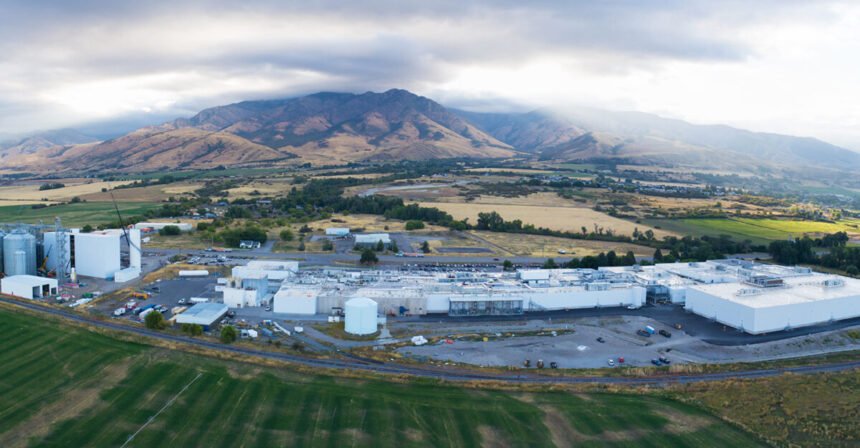Since its U.S. introduction in 1962, the Goldfish cracker brand has made a splash — generating $1 billion in annual sales in 2024.
But to get more of the “snack that smiles back” into American homes — including those on the West Coast — The Campbell’s Company’s cracker and cookie plant in Richmond, Utah, needed some help, says Tony Hernandez, director of site operations.
“Goldfish was on a very high growth trajectory,” he says. “We were capacity-constrained, especially coming out of COVID. It highlighted the need to increase the bakery’s output.”
Last year, the company completed Project FINN, a $160 million expansion of the Richmond plant that included commissioning a fourth cracker line, expanding the plant’s footprint by 100,000 sq. ft. to 400,000 sq. ft., and remodeling 75,000 sq. ft. of existing space.
Not only does the new line allow Campbell’s to produce 5 million Goldfish per hour, but the project also set new standards for packaging and the company’s process for executing capital projects. Further, the project earned an honorable mention for FOOD ENGINEERING’s 2025 Plant of the Year.
Seeking to Expand
Much of Campbell’s Goldfish production exists east of the Mississippi River, with plants in Willard, Ohio, and Denver, Pa., producing the classic crackers and a plant in Franklin, Wis., manufacturing Goldfish Crisps.
Campbell’s Richmond plant is responsible for serving the western U.S., including the major markets of California and Texas. Even with three Goldfish production lines, the Richmond facility required support from Campbell’s manufacturing network to meet the region’s demand, Hernandez says.
“From a geographic perspective, it made sense to expand production out here,” he says. “Prior to the expansion, we were getting support from Willard and Denver sending products out west because we couldn’t produce everything needed.”
At a Glance
Location: Richmond, Utah
Open Date: 1974
Employees: 450
Square Footage: 400,000 sq. ft. (after expansion)
Products Produced: Goldfish Crackers, Pepperidge Farms Cookies
Jason Roethig, senior director of engineering services and project execution, also pointed to the abundance of wheat production in the area. Specifically, Utah produced 4.41 million bushels and Idaho produced 62.3 million bushels of winter wheat in 2024, according to the USDA’s National Agricultural Statistics Service.
“A lot of the wheat in America is around the Palouse area, which is in Northern Idaho, and then along with the Utah Valley, so taking advantage of the local wheat production and connecting that with the flour mill building was really attractive,” he says.
Drawing on Experience
Before kicking off Project FINN — named for the Goldfish cracker mascot, Finn — Campbell’s corporate engineering team gathered best practices from the company’s Meals & Beverages and Snacks divisions. Campbell’s also assigned Marta H. Mulyk as project manager, who was responsible for directing the overall project and managing the relationship with design-build firm Dennis Group.
“Dennis Group has been a very good partner for both Campbell’s and the plant,” Hernandez says. “They worked on a few projects previous to this, so they came in with a very good background and knowledge of the site. They’re also local — they have a large office in Salt Lake City. It was very easy for people to travel to the site and get eyes where they needed to.”
Campbell’s also named Andrew Butler as project delivery leader. He was responsible for coordinating the company’s internal teams across leadership, maintenance, operations, R&D, quality and safety for a smooth startup. Meanwhile, Bruce Granbois served as Campbell’s owner’s representative.
“He was able to connect all the dots, and I believe if you ask Bruce right now, he knows everybody in that plant by name, including the construction managers,” Roethig says. “People knew him, people appreciated him, and that was certainly a real big benefit to us to bring in Bruce.”
The company also tapped senior operations and maintenance professionals at its Willard plant to provide expertise and hands-on training for Richmond employees. Additionally, Campbell’s dispatched operators to vendor shops across the U.S. and Europe for factory acceptance testing.
Engineering work began in 2022, and Campbell’s officially announced the expansion in July 2023.
Design and Benefits
Campbell’s turned to its equipment vendors to enhance flexibility, quality and speed. That included leveraging longstanding relationships, such as its 20-year partnership with Fallas Automation, as well as collaborating with new partners, Hernandez says.
For small-pouch packaging — a high-growth format for Campbell’s — the company purchased scales and bagging machines from the same vendor to support seamless integration. This allowed the machines to achieve speeds that are 35% faster than anywhere else in the Goldfish manufacturing network.

Additionally, Campbell’s implemented a new recipe management system. The company installed it on an existing Goldfish line to test it before commissioning the new equipment. Roethig says the recipe management system provides better control of the ingredients and a more consistent dough.
Campbell’s also added colored equipment lights that serve as visual, real-time indicators, helping operators to act quickly and reduce time troubleshooting equipment concerns. As a result, their tasks have been simplified, allowing operators to oversee a larger area.
On-Site Flour Mill
Flour is a key ingredient for Goldfish crackers, so ensuring a consistent, sustainable supply is paramount. Hernandez says Campbell’s had concerns since the mills the Richmond plant previously sourced from were capacity-strained and aging, with one being more than a century old.
Following a best practice employed at the Willard plant, Campbell’s reached out to milling companies it previously partnered with to gauge interest in building a mill in Richmond.
PHM Brands’ Panhandle Milling and NIPPN Corporation answered the call, forming Utah Flour Milling LLC. While the company is partnering with Campbell’s, Utah Flour Milling built, owns and operates the mill. As its primary customer, Campbell’s receives 50% of the mill’s 750,000-lb. daily output, and the flour is piped directly into the Richmond facility.
“That’s been a huge win for us,” Hernandez says. “It’s a state-of-the-art milling operation, so the quality and the consistency are best-in-class. We’ve noticed a difference in the yields, in the flour and how it runs in our process for the better.”
Hernandez also points to the sustainability benefits of an on-site flour mill. The Richmond plant would receive six to eight truckloads of flour per day, but with the mill, the company has eliminated 2,236 truckloads and 1,472 metric tons of carbon dioxide equivalent (CO2e) per year.
The mill also presents new opportunities for wheat farmers in northern Utah and southern Idaho.
“It’s another cool connection that the product we’re making, sending throughout the country — the main ingredient, flour — is from this area,” Hernandez says. “It truly is a local flavor in the product. It’s been great for the local farmers. They have additional buyers for their wheat, which helps with price competition. It’s been a great improvement for them.”

Construction Challenges
Even with meticulous planning, the expansion project faced several challenges — the primary one being continuing production throughout construction.
Hernandez says the engineering, safety and quality teams, along with Granbois and the Dennis Group’s construction manager, would conduct walkthroughs and review a checklist before any scheduled work began to determine where to set up temporary walls and which equipment had to be taken down or covered.
“That was a great process for us,” he says. “That helped us avoid any product contamination or safety issues. It was very successful that way.”
Snow is a regular concern in Utah, but during the winter of 2023, Cache Valley received a record-130 inches, adding another layer of difficulty to construction and site work. Hernandez says the snow came in one to two storms a week, in increments of up to 12 inches.
“From my perspective — from plant engineering — it was a safety concern because of ice buildup in the construction site,” he says. “It was making sure the facility was kept clear, and snow removal was a priority to make sure people weren’t slipping and falling while doing difficult work already when you don’t have the elements to worry about.”
Campbell’s also experienced extra competition for Salt Lake City-area contractors, thanks to other major construction in the region, including the ongoing, $5.1 billion improvement project at Salt Lake City International Airport.
Specifically, the company couldn’t find a local electrical vendor to meet their timeline, but Mulyk brought in contractors that had worked on three of Campbell’s Ohio facilities to supplement the local electrical group and divide the work.
“Because they were a strategic partner with our Ohio sites, they were able to do that quickly and respond very fast at a reasonable price because of our negotiated rates with them,” Roethig says.
Construction Challenges
Even with meticulous planning, the expansion project faced several challenges — the primary one being continuing production throughout construction.
Hernandez says the engineering, safety and quality teams, along with Granbois and the Dennis Group’s construction manager, would conduct walk-throughs and review a checklist before any scheduled work began to determine where to set up temporary walls and which equipment had to be taken down or covered.
“That was a great process for us,” he says. “That helped us avoid any product contamination or safety issues. It was very successful that way.”
Snow is a regular concern in Utah, but during the winter of 2023, Cache Valley received a record-130 inches, adding another layer of difficulty to construction and site work. Hernandez says the snow came in one to two storms a week, in increments of up to 12 inches.
“From my perspective — from plant engineering — it was a safety concern because of ice buildup in the construction site,” he says. “It was making sure the facility was kept clear, and snow removal was a priority to make sure people weren’t slipping and falling while doing difficult work already when you don’t have the elements to worry about.”
Campbell’s also experienced extra competition for Salt Lake City-area contractors, thanks to other major construction in the region, including the ongoing, $5.1 billion improvement project at Salt Lake City International Airport.
Specifically, the company couldn’t find a local electrical vendor to meet their timeline, but Mulyk brought in contractors that had worked on three of Campbell’s Ohio facilities to supplement the local electrical group and divide the work.
“Because they were a strategic partner with our Ohio sites, they were able to do that quickly and respond very fast at a reasonable price because of our negotiated rates with them,” Roethig says.
What’s Next
The Richmond plant’s new Goldfish line began running at its full rate in the third quarter of 2024. The project, which spanned 394,539 work hours with no lost time and no recordable safety incidents, was completed on time and on budget. Campbell’s also expects to add 85 jobs by 2027.
“We have hit our success criteria for startup, but we feel there is opportunity to continue to unlock efficiencies,” Hernandez says. “With any startup, you get new equipment, and there is a learning curve there for the maintenance team, for the operations team. It’s really making sure our standards are solid.”
Additionally, the Richmond expansion served as a proving ground for a safety and project checklist that Campbell’s will roll out to every new capital project that requires operational readiness, Roethig says.
“This new, cross-functional operational readiness process helped us achieve a vertical startup to ensure optimal internal and external process operations,” he says. “This enabled proper startup procedures, training, maintenance and vendor interactions with new operators and a world-class safety program. In addition, post-mortem lessons learned kept us more effective for improving in the future.”
Hernandez says there are no immediate plans to further expand the plant, but there is room if it becomes necessary. If it happens, the Richmond team will be ready.
“We’ve proven that if given the opportunity, then we’ll be successful with that in the future with the teams that we have here,” he says.











